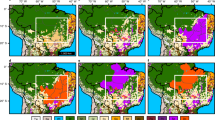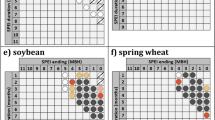Abstract
Drought-induced agricultural loss is one of the most costly impacts of extreme weather1–3, and without mitigation, climate change is likely to increase the severity and frequency of future droughts4,5. The Dust Bowl of the 1930s was the driest and hottest for agriculture in modern US history. Improvements in farming practices have increased productivity, but yields today are still tightly linked to climate variation6 and the impacts of a 1930s-type drought on current and future agricultural systems remain unclear. Simulations of biophysical process and empirical models suggest that Dust-Bowl-type droughts today would have unprecedented consequences, with yield losses ∼50% larger than the severe drought of 2012. Damages at these extremes are highly sensitive to temperature, worsening by ∼25% with each degree centigrade of warming. We find that high temperatures can be more damaging than rainfall deficit, and, without adaptation, warmer mid-century temperatures with even average precipitation could lead to maize losses equivalent to the Dust Bowl drought. Warmer temperatures alongside consecutive droughts could make up to 85% of rain-fed maize at risk of changes that may persist for decades. Understanding the interactions of weather extremes and a changing agricultural system is therefore critical to effectively respond to, and minimize, the impacts of the next extreme drought event.
This is a preview of subscription content, access via your institution
Access options
Subscribe to this journal
Receive 12 digital issues and online access to articles
$119.00 per year
only $9.92 per issue
Buy this article
- Purchase on Springer Link
- Instant access to full article PDF
Prices may be subject to local taxes which are calculated during checkout



Similar content being viewed by others
References
National Mitigation Strategy – Partnerships for Building Safer Communities (Federal Emergency Management Agency, 1995).
Smith, A. B. & Katz, R. W. US billion-dollar weather and climate disasters: data sources, trends, accuracy and biases. Nat. Hazards 67, 387–410 (2013).
Billion-dollar weather and climate disasters. NOAA National Centers for Environmental Information (NCEI)https://www.ncdc.noaa.gov/billions/ (2015).
Sheffield, J. & Wood, E. F. Projected changes in drought occurrence under future global warming from multi-model, multi-scenario, IPCC AR4 simulations. Clim. Dyn. 31, 79–105 (2008).
Wehner, M. et al. Projections of future drought in the continental United States and Mexico. J. Hydrometeorol. 12, 1359–1377 (2011).
Ray, D. K., Gerber, J. S., MacDonald, G. K. & West, P. C. Climate variation explains a third of global crop yield variability. Nat. Commun. 6, 5989 (2015).
Warrick, R. A. The possible impacts on wheat production of a recurrence of the 1930s drought in the US Great Plains. Clim. Change 6, 5–26 (1984).
Hansen, Z. K. & Libecap, G. D. Small farms, externalities, and the Dust Bowl of the 1930's. J. Polit. Econ. 112, 665–694 (2004).
Hornbeck, R. The enduring impact of the American Dust Bowl: short and long-run adjustments to environmental catastrophe. Am. Econ. Rev. 102, 1477–1507 (2012).
Parton, W. J., Gutmann, M. P. & Ojima, D. Long-term trends in population, farm income, and crop production in the Great Plains. Bioscience 57, 737–747 (2007).
McLeman, R. A. et al. What we learned from the Dust Bowl: lessons in science, policy, and adaptation. Popul. Environ. 35, 417–440 (2014).
Rosenberg, N. J. & Crosson, P. R. The MINK Project: a new methodology for identifying regional influences of, and responses to, increasing atmospheric CO2 and climate change. Environ. Conserv. 18, 313–322 (1991).
Rosenzweig, C. & Hillel, D. The Dust Bowl of the 1930s: analog of greenhouse effect in the Great Plains? J. Environ. Qual. 22, 9–22 (1993).
Extreme Weather and Resilience of the Global Food System (The Global Food Security programme, 2015).
Lobell, D. B., Schlenker, W. & Costa-Roberts, J. Climate trends and global crop production since 1980. Science 333, 616–620 (2011).
Urban, D., Roberts, M. J., Schlenker, W. & Lobell, D. B. Projected temperature changes indicate significant increase in interannual variability of US maize yields. Clim. Change 112, 525–533 (2012).
Cook, B. I., Seager, R. & Smerdon, J. E. The worst North American drought year of the last millennium: 1934. Geophys. Res. Lett. 41, 7298–7305 (2014).
Hatfield, J. L. et al. Climate impacts on agriculture: implications for crop production. Agronomy J. 103, 351–370 (2011).
Scanlon, B. R. et al. Groundwater depletion and sustainability of irrigation in the US High Plains and Central Valley. Proc. Natl Acad. Sci. USA 109, 9320–9325 (2012).
Elliott, J. et al. Constraints and potentials of future irrigation water availability on agricultural production under climate change. Proc. Natl Acad. Sci. USA 111, 3239–3244 (2014).
Blum, A. Drought resistance, water-use efficiency, and yield potential—are they compatible, dissonant, or mutually exclusive? Crop Pasture Sci. 56, 1159–1168 (2005).
Lewandrowski, J. & Brazee, R. Farm programs and climate change. Clim. Change 23, 1–20 (1993).
Wahid, A., Gelani, S., Ashraf, M. & Foolad, M. R. Heat tolerance in plants: an overview. Environ. Exp. Bot. 61, 199–223 (2007).
Bita, C. E. & Gerats, T. Plant tolerance to high temperature in a changing environment: scientific fundamentals and production of heat stress-tolerant crops. Front. Plant Sci. 4, 273 (2013).
Cook, B. I., Miller, R. L. & Seager, R. Amplification of the North American ‘Dust bowl’ drought through human-induced land degradation. Proc. Natl Acad. Sci. USA 106, 4997–5001 (2009).
Cook, B. I., Seager, R. & Miller, R. L. Atmospheric circulation anomalies during two persistent North American droughts: 1932–1939 and 1948–1957. Clim. Dyn. 36, 2339–2355 (2011).
Cook, B. I., Ault, T. R. & Smerdon, J. E. Unprecedented 21st century drought risk in the American Southwest and Central Plains. Sci. Adv. 1, e1400082 (2015).
Ault, T. R., Cole, J. E., Overpeck, J. T., Pederson, G. T. & Meko, D. M. Assessing the risk of persistent drought using climate model simulations and paleoclimate data. J. Climate 27, 7529–7549 (2014).
Munson, S. M., Belnap, J. & Okin, G. S. Responses of wind erosion to climate-induced vegetation changes on the Colorado Plateau. Proc. Natl Acad. Sci. USA 108, 3854–3859 (2011).
Lesk, C., Rowhani, P. & Ramankutty, N. Influence of extreme weather disasters on global crop production. Nature 529, 84–87 (2016).
Jones, J. et al. The DSSAT cropping system model. Eur. J. Agron. 18, 235–265 (2003).
Hoogenboom, G. et al. Decision Support System and Agrotechnology Transfer (DSSAT) v.4.6 (DSSAT Foundation, 2015); http://dssat.net
Elliott, J. et al. The parallel system for integrating impact models and sectors (pSIMS). Environ. Model. Softw. 62, 509–516 (2014).
Zhao, Y. et al. in 2007 IEEE Congress on Services 199–206 (IEEE, 2007).
Crop Progress (NASS, 1995–2013); https://usda.mannlib.cornell.edu/MannUsda/viewDocumentInfo.do?documentID=1048
Elliott, J. et al. Predicting agricultural impacts of large-scale drought: 2012 and the case for better modeling. Preprint at http://dx.doi.org/10.2139/ssrn.2222269 (2013).
Thornton, P. E. et al. Daymet: Daily Surface Weather Data on a 1-km grid for North America, Version 2. (Oak Ridge National Laboratory Distributed Active Archive Center, 2014); https://daac.ornl.gov/cgi-bin/dsviewer.pl?ds_id=1219
Portmann, F. T., Siebert, S. & Döll, P. MIRCA2000—Global monthly irrigated and rainfed crop areas around the year 2000: a new high-resolution data set for agricultural and hydrological modeling. Glob. Biogeochem. Cycles http://dx.doi.org/10.1029/2008GB003435 (2010).
Shangguan, W., Dai, Y., Duan, Q., Liu, B. & Yuan, H. A global soil data set for earth system modeling. J. Adv. Model. Earth Sys. 6, 249–263 (2014).
Kim, H. Global Soil Wetness Project Phase 3 (2014); http://hydro.iis.u-tokyo.ac.jp/GSWP3/
Sheffield, J., Goteti, G. & Wood, E. F. Development of a 50-year high-resolution global dataset of meteorological forcings for land surface modeling. J. Climate 19, 3088–3111 (2006).
Compo, G. P. et al. The twentieth century reanalysis project. Q. J. R. Meteorol. Soc. 137, 1–28 (2011).
Harris, I., Jones, P., Osborn, T. & Lister, D. Updated high-resolution grids of monthly climatic observations—the CRU TS3.10 dataset. Intern. J. Climatol. 34, 623–642 (2014).
Sacks, W. J. & Kucharik, C. J. Crop management and phenology trends in the US Corn Belt: Impacts on yields, evapotranspiration and energy balance. Agric. For. Meteorol. 151, 882–894 (2011).
Mourtzinis, S. et al. Climate-induced reduction in US-wide soybean yields underpinned by region-and in-season-specific responses. Nat. Plants 1, 14026 (2015).
Setiyono, T. et al. Understanding and modeling the effect of temperature and daylength on soybean phenology under high-yield conditions. Field Crops Res. 100, 257–271 (2007).
USDA National Agricultural Statistics Service (accessed 8 February 2016); http://www.nass.usda.gov/
Good, D. Corn and soybean production—some unfinished business. University of Illinois Extension (19 September 2013); http://web.extension.illinois.edu/cefj/news/news29698.html
Rosenzweig, C., Tubiello, F. N., Goldberg, R., Mills, E. & Bloomfield, J. Increased crop damage in the US from excess precipitation under climate change. Glob. Environ. Change. 12, 197–202 (2002).
Livneh, B. & Hoerling, M. P. The physics of drought in the US central Great Plains. J. Climate 29, 6783–6804 (2016).
Kay, J. et al. The Community Earth System Model (CESM) large ensemble project: a community resource for studying climate change in the presence of internal climate variability. Bull. Am. Meteorol. Soc. 96, 1333–1349 (2015).
Seager, R., Kushnir, Y., Herweijer, C., Naik, N. & Velez, J. Modeling of tropical forcing of persistent droughts and pluvials over western North America: 1856–2000. J. Climate 18, 4065–4088 (2005).
Schubert, S. D., Suarez, M. J., Pegion, P. J., Koster, R. D. & Bacmeister, J. T. On the cause of the 1930s Dust Bowl. Science 303, 1855–1859 (2004).
Seager, R. et al. Would advance knowledge of 1930s SSTs have allowed prediction of the Dust Bowl drought?. J. Climate 21, 3261–3281 (2008).
Cook, B. I., Miller, R. L. & Seager, R. Dust and sea surface temperature forcing of the 1930s ‘Dust Bowl’ drought. Geophys. Res. Lett. 35 (2008).
Cunfer, G. On the Great Plains: Agriculture and Environment (Texas A&M Univ. Press, 2005).
Acknowledgements
This research was performed as part of the Center for Robust Decision-making on Climate and Energy Policy (RDCEP) at the University of Chicago. RDCEP is funded by a grant from NSF (no. SES-0951576) through the Decision Making Under Uncertainty program. M.G. acknowledges support of an NSF Graduate Fellowship (no. DGE-1144082). We thank C. Müller, A. Ruane and J. Winter—as well as the AgMIP (Agricultural Model Intercomparison and Improvement Project) community—for valuable insight in formulating the ideas for this research. We acknowledge the World Climate Research Programme's Working Group on Coupled Modelling, and we thank the climate modelling groups for producing and making available their model output. For CMIP, the US Department of Energy's Program for Climate Model Diagnosis and Intercomparison provides coordinating support and software infrastructure development in partnership with the Global Organization for Earth System Science Portals. Computing for this project was facilitated using the Swift parallel scripting language (NSF grant OCI-1148443), and completed in part with resources provided by the University of Chicago Research Computing Center.
Author information
Authors and Affiliations
Contributions
M.G. and J.E. contributed equally to this work. Both authors designed and performed the experiments, analysed the data, discussed the results, and wrote the paper.
Corresponding authors
Ethics declarations
Competing interests
The authors declare no competing financial interests.
Supplementary information
Supplementary Information
Supplementary Figures 1–11. (PDF 2510 kb)
Rights and permissions
About this article
Cite this article
Glotter, M., Elliott, J. Simulating US agriculture in a modern Dust Bowl drought. Nature Plants 3, 16193 (2017). https://doi.org/10.1038/nplants.2016.193
Received:
Accepted:
Published:
DOI: https://doi.org/10.1038/nplants.2016.193
This article is cited by
-
Compound heat and moisture extreme impacts on global crop yields under climate change
Nature Reviews Earth & Environment (2022)
-
The impact of 1.5 °C and 2.0 °C global warming on global maize production and trade
Scientific Reports (2022)
-
Present-day greenhouse gases could cause more frequent and longer Dust Bowl heatwaves
Nature Climate Change (2020)
-
Larger-scale ocean-atmospheric patterns drive synergistic variability and world-wide volatility of wheat yields
Scientific Reports (2020)



